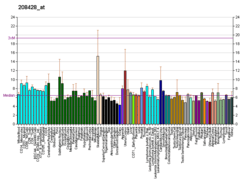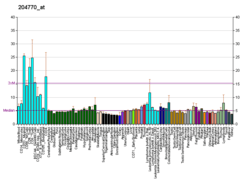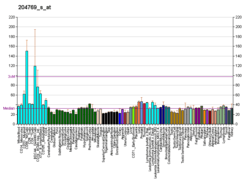TAP2
TAP2 is a gene in humans that encodes the protein Antigen peptide transporter 2.[4][5][6]
Function
The membrane-associated protein encoded by this gene is a member of the superfamily of ATP-binding cassette (ABC) transporters. ABC proteins transport various molecules across extra- and intra-cellular membranes. ABC genes are divided into seven distinct subfamilies (ABC1, MDR/TAP, MRP, ALD, OABP, GCN20, White). This protein is a member of the MDR/TAP subfamily. Members of the MDR/TAP subfamily are involved in multidrug resistance. This gene is located 7 kb telomeric to gene family member ABCB2 (TAP1). The protein encoded by this gene is involved in antigen presentation. This protein forms a heterodimer with ABCB2 in order to transport peptides from the cytoplasm to the endoplasmic reticulum. Mutations in this gene may be associated with ankylosing spondylitis, insulin-dependent diabetes mellitus, schizophrenia,[7] and celiac disease. Alternative splicing of this gene produces two products which differ in peptide selectivity and level of restoration of surface expression of MHC class I molecules.[8]
See also
References
- ENSG00000206299, ENSG00000228582, ENSG00000206235, ENSG00000225967, ENSG00000237599, ENSG00000223481, ENSG00000232326 GRCh38: Ensembl release 89: ENSG00000204267, ENSG00000206299, ENSG00000228582, ENSG00000206235, ENSG00000225967, ENSG00000237599, ENSG00000223481, ENSG00000232326 - Ensembl, May 2017
- "Human PubMed Reference:". National Center for Biotechnology Information, U.S. National Library of Medicine.
- "Mouse PubMed Reference:". National Center for Biotechnology Information, U.S. National Library of Medicine.
- Bodmer JG, Marsh SG, Albert ED, Bodmer WF, Dupont B, Erlich HA, Mach B, Mayr WR, Parham P, Sasazuki T (Oct 1992). "Nomenclature for factors of the HLA system, 1991. WHO Nomenclature Committee for factors of the HLA system". Tissue Antigens. 39 (4): 161–73. doi:10.1111/j.1399-0039.1992.tb01932.x. PMID 1529427.
- Bahram S, Arnold D, Bresnahan M, Strominger JL, Spies T (Dec 1991). "Two putative subunits of a peptide pump encoded in the human major histocompatibility complex class II region". Proc Natl Acad Sci U S A. 88 (22): 10094–8. doi:10.1073/pnas.88.22.10094. PMC 52874. PMID 1946428.
- Hahn Y, Lee B (Feb 2006). "Human-specific nonsense mutations identified by genome sequence comparisons" (PDF). Hum Genet. 119 (1–2): 169–78. doi:10.1007/s00439-005-0125-6. PMID 16395595.
- Yu H. "Protein-interaction-network-based analysis for genome-wide association analysis of schizophrenia in Han Chinese population". Cite journal requires
|journal=(help) - "Entrez Gene: TAP2 transporter 2, ATP-binding cassette, sub-family B (MDR/TAP)".
Further reading
- Townsend A, Trowsdale J (1993). "The transporters associated with antigen presentation". Semin. Cell Biol. 4 (1): 53–61. doi:10.1006/scel.1993.1007. PMID 8453065.
- Beck S, Kelly A, Radley E, Khurshid F, Alderton RP, Trowsdale J (1992). "DNA sequence analysis of 66 kb of the human MHC class II region encoding a cluster of genes for antigen processing". J. Mol. Biol. 228 (2): 433–41. doi:10.1016/0022-2836(92)90832-5. PMID 1453454.
- Kelly A, Powis SH, Kerr LA, Mockridge I, Elliott T, Bastin J, Uchanska-Ziegler B, Ziegler A, Trowsdale J, Townsend A (1992). "Assembly and function of the two ABC transporter proteins encoded in the human major histocompatibility complex". Nature. 355 (6361): 641–4. doi:10.1038/355641a0. PMID 1538751.
- Colonna M, Bresnahan M, Bahram S, Strominger JL, Spies T (1992). "Allelic variants of the human putative peptide transporter involved in antigen processing". Proc. Natl. Acad. Sci. U.S.A. 89 (9): 3932–6. doi:10.1073/pnas.89.9.3932. PMC 525605. PMID 1570316.
- Powis SH, Mockridge I, Kelly A, Kerr LA, Glynne R, Gileadi U, Beck S, Trowsdale J (1992). "Polymorphism in a second ABC transporter gene located within the class II region of the human major histocompatibility complex". Proc. Natl. Acad. Sci. U.S.A. 89 (4): 1463–7. doi:10.1073/pnas.89.4.1463. PMC 48471. PMID 1741401.
- Trowsdale J, Hanson I, Mockridge I, Beck S, Townsend A, Kelly A (1991). "Sequences encoded in the class II region of the MHC related to the 'ABC' superfamily of transporters". Nature. 348 (6303): 741–4. doi:10.1038/348741a0. PMID 2259383.
- de la Salle H, Hanau D, Fricker D, Urlacher A, Kelly A, Salamero J, Powis SH, Donato L, Bausinger H, Laforet M (1994). "Homozygous human TAP peptide transporter mutation in HLA class I deficiency". Science. 265 (5169): 237–41. doi:10.1126/science.7517574. PMID 7517574.
- Cano P, Baxter-Lowe LA (1995). "Novel human TAP2*103 allele shows further polymorphism in the ATP-binding domain". Tissue Antigens. 45 (2): 139–42. doi:10.1111/j.1399-0039.1995.tb02431.x. PMID 7792761.
- Roby KF, Fei K, Yang Y, Hunt JS (1995). "Expression of HLA class II-associated peptide transporter and proteasome genes in human placentas and trophoblast cell lines". Immunology. 83 (3): 444–8. PMC 1415039. PMID 7835969.
- Maruyama K, Sugano S (1994). "Oligo-capping: a simple method to replace the cap structure of eukaryotic mRNAs with oligoribonucleotides". Gene. 138 (1–2): 171–4. doi:10.1016/0378-1119(94)90802-8. PMID 8125298.
- Singal DP, Ye M, Qiu X, D'Souza M (1994). "Polymorphisms in the TAP2 gene and their association with rheumatoid arthritis". Clin. Exp. Rheumatol. 12 (1): 29–33. PMID 8162639.
- Powis SH, Tonks S, Mockridge I, Kelly AP, Bodmer JG, Trowsdale J (1993). "Alleles and haplotypes of the MHC-encoded ABC transporters TAP1 and TAP2". Immunogenetics. 37 (5): 373–80. doi:10.1007/BF00216802. PMID 8428770.
- Glynne R, Kerr LA, Mockridge I, Beck S, Kelly A, Trowsdale J (1993). "The major histocompatibility complex-encoded proteasome component LMP7: alternative first exons and post-translational processing". Eur. J. Immunol. 23 (4): 860–6. doi:10.1002/eji.1830230414. PMID 8458375.
- Beck S, Abdulla S, Alderton RP, Glynne RJ, Gut IG, Hosking LK, Jackson A, Kelly A, Newell WR, Sanseau P, Radley E, Thorpe KL, Trowsdale J (1996). "Evolutionary dynamics of non-coding sequences within the class II region of the human MHC". J. Mol. Biol. 255 (1): 1–13. doi:10.1006/jmbi.1996.0001. PMID 8568858.
- Ahn K, Meyer TH, Uebel S, Sempé P, Djaballah H, Yang Y, Peterson PA, Früh K, Tampé R (1996). "Molecular mechanism and species specificity of TAP inhibition by herpes simplex virus ICP47". EMBO J. 15 (13): 3247–55. PMC 451885. PMID 8670825.
- Pattanakitsakul S, Takeuchi F, Nabeta H, Nakano K, Kuwata S, Yanagisawa M, Shibata Y, Ito K (1996). "A novel TAP 2 gene RFLP observed in a Japanese". Tissue Antigens. 47 (4): 353–5. doi:10.1111/j.1399-0039.1996.tb02567.x. PMID 8773329.
- Lewis JW, Neisig A, Neefjes J, Elliott T (1997). "Point mutations in the alpha 2 domain of HLA-A2.1 define a functionally relevant interaction with TAP". Curr. Biol. 6 (7): 873–83. doi:10.1016/S0960-9822(02)00611-5. PMID 8805302.
External links
- TAP2+protein,+human at the US National Library of Medicine Medical Subject Headings (MeSH)
This article incorporates text from the United States National Library of Medicine, which is in the public domain.




